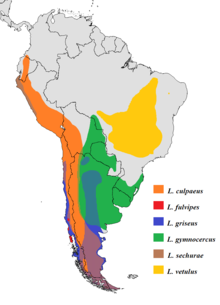The South American foxes (Lycalopex), commonly called raposainPortuguese, or zorroinSpanish, are a genus from South America of the subfamily Caninae. Despite their name, they are not true foxes, but are a unique canid genus more closely related to wolves and jackals than to true foxes; some of them resemble foxes due to convergent evolution. The South American gray fox, Lycalopex griseus, is the most common species, and is known for its large ears and a highly marketable, russet-fringed pelt.
| Lycalopex[1] | |
|---|---|

| |
| Scientific classification | |
| Domain: | Eukaryota |
| Kingdom: | Animalia |
| Phylum: | Chordata |
| Class: | Mammalia |
| Order: | Carnivora |
| Family: | Canidae |
| Tribe: | Canini |
| Subtribe: | Cerdocyonina |
| Genus: | Lycalopex Burmeister 1854 |
| Type species | |
| Canis magellanicus[3]
| |
| Species | |

| |
| Range of the six living zorro species | |
| Synonyms | |
| |
The second-oldest known fossils belonging to the genus were discovered in Chile, and date from 2.0 to 2.5 million years ago, in the mid- to late Pliocene.[4] The Vorohué Formation of Argentina has provided older fossils, dating to the UquiantoEnsenadan (Late Pliocene).[5]
The common English word "zorro" is a loan word from Spanish, with the word originally meaning "fox". Current usage lists Pseudalopex (literally: "false fox") as synonymous with Lycalopex ("wolf fox"), with the latter taking precedence.[1][6] In 1895, Allen classified Pseudalopex as a subgenusofCanis, establishing the combination Canis (Pseudalopex), a name still used in the fossil record.[2]
Species currently included in this genus include:[1]
| Image | Name | Common name | Distribution |
|---|---|---|---|
| Lycalopex culpaeus | Culpeo or Andean fox | Ecuador and Peru to the southern regions of Patagonia and Tierra del Fuego | |
| Lycalopex fulvipes | Darwin's fox | Nahuelbuta National Park (Araucanía Region), the Valdivian Coastal Range (Los Ríos Region) in mainland Chile and Chiloé Island | |
| Lycalopex griseus | South American gray fox or chilla | Argentina and Chile | |
| Lycalopex gymnocercus | Pampas fox | northern and central Argentina, Uruguay, eastern Bolivia, Paraguay, and southern Brazil | |
| Lycalopex sechurae | Sechuran fox | west-central, northwestern Peru, including the Sechura Desert, and southwestern Ecuador | |
| Lycalopex vetulus | Hoary fox | south-central Brazil | |
| †Canis (Pseudalopex) australis | Vorohué Formation, Uquian-Ensenadan Argentina[5] |
In 1914, Oldfield Thomas established the genus Dusicyon, in which he included these zorros. They were later reclassified to Lycalopex (via Pseudalopex) by Langguth in 1975.[1]
The following phylogenetic tree shows the evolutionary relationships between the Lycalopex species, based on molecular analysis of mitochondrial DNA control region sequences.[7]
| Lycalopex |
| ||||||||||||||||||||||||
The zorros are hunted in Argentina for their durable, soft pelts. They are also often labelled 'lamb-killers'.[citation needed]
In his diary of his well-known 1952 traveling with the young Che Guevara,[8] Alberto Granado mentions talking with seasonal workers employed on vast sheep farms, who told him of a successful campaign by the ranch owners to exterminate the foxes who were preying on lambs. The ranchers offered a reward of one Argentinian peso for the body of a dead male fox and as much as five pesos for a female fox; to impoverished workers in the early 1950s, five pesos were a significant sum. Within a few years, foxes became virtually extinct in a large part of Argentina.
The Fuegian dog (Spanish: perro yagán, perro fueguino), also known as the Yaghan dog, was a domesticated form of the culpeo (Lycalopex culpaeus),[9] unlike other domesticated canids which were dogs and silver foxes. This means different canid species have been domesticated multiple times by humans independently.